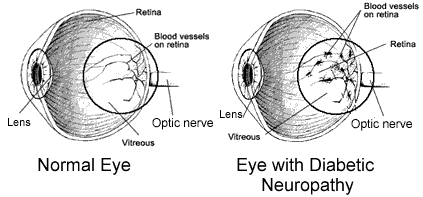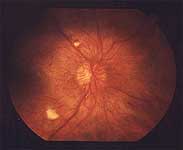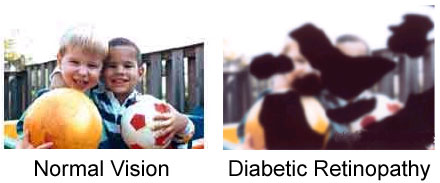Diabetic Retinopathy
What is it?
Our bodies use food as a source of energy. The main source of energy in
food is glucose, a form of sugar. As food is digested, it is broken down
into glucose molecules which enter the bloodstream and are distributed to
cells throughout the body. For glucose to enter cells, however,
insulin, a hormone produced by the pancreas, must be
present.
Normally, enough insulin is produced to move glucose into cells. In
people with diabetes, however, either not enough insulin is produced or
cells do not respond properly to the insulin. As a result, glucose
remains in the blood and cells are not provided with their main energy
source.
High blood sugar levels affect many tissues in the body including the
skin, heart, kidneys, nervous system, feet, teeth, gums and eyes.
Diabetic retinopathy refers to damage to the blood vessels of the retina
caused by diabetes. These blood vessels bring oxygen and nutrients to the
retina. When the blood vessels are become damaged, they weaken and
sometimes break, leaking fluid into the retina and causing the retina may
to swell. As new blood vessels grow on the retina, blurred vision or
temporary blindness can result. Scare tissue can form and cause blindness
where old blood vessles were attached to the retina.
 |

Photograph of
the retina
showing abnormal new blood vessels and scar tissue in an advanced stage of
retinal neuropathy. |
Images modified from National Institute of Diabetes and Digestive and
Kidney Diseases and National Eye Institute, National Institutes of
Health |
Symptoms
| Diabetic neuropathy may cause:
- Spots floating in the visual field
- Vision loss
- Poor night vision
- Blurred vision
|

Image modified from National Eye Institute, National Institutes of Health
|
Risk Factors
- Diabetes
- Kidney Disease: people with kidney disease have an increased risk of
diabetic retinopathy.
- High Blood Pressure: people with high blood pressure have an increased
risk of diabetic retinopathy.
- High Blood Fat: people with high blood fat have an increased
risk of diabetic retinopathy.
- Obesity: people who are overweight have an an increased risk of
diabetic retinopathy.
- Pregnancy: women who are pregnant have an increased risk of diabetic
retinopathy.
Diagnosis
- Eye examination: an eye doctor will look for a swollen retina,
leaking blood vessels, optic nerve damage, and retinal detachments.
Treatment
- Photocoagulation: a laser is used to stop bleeding of retinal blood
vessels.
- Vitrectomy: the vitreous and scar tissue is removed and then replaced
with clear fluid.
Did you know? | According to the
National Eye Institute, diabetic
retinopathy is the leading cause of blindness in American adults.
Diabetic retinopathy accounts for 12% of all new cases of blindness in the
US (reference: Duh, E.J. and Aiello, L.P. Basic
Pathobiology of the eye and its complications, in Porte, Jr. et al.,
editors, Ellenberg & Rifkin's Diabetes Mellitus, New York:
McGraw-Hill, 2002.) |



